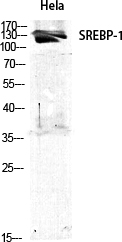
| WB | 咨询技术 | Human,Mouse,Rat |
| IF | 咨询技术 | Human,Mouse,Rat |
| IHC | 1/100-1/300 | Human,Mouse,Rat |
| ICC | 技术咨询 | Human,Mouse,Rat |
| FCM | 咨询技术 | Human,Mouse,Rat |
| Elisa | 1/20000 | Human,Mouse,Rat |
| Aliases | SREBF1; BHLHD1; SREBP1; Sterol regulatory element-binding protein 1; SREBP-1; Class D basic helix-loop-helix protein 1; bHLHd1; Sterol regulatory element-binding transcription factor 1 |
| Entrez GeneID | 6720; |
| WB Predicted band size | 122kDa |
| Host/Isotype | Rabbit IgG |
| Antibody Type | Primary antibody |
| Storage | Store at 4°C short term. Aliquot and store at -20°C long term. Avoid freeze/thaw cycles. |
| Species Reactivity | Human,Rat |
| Immunogen | Synthesized peptide derived from human SREBP-1 around the non-phosphorylation site of S439. |
| Formulation | Purified antibody in PBS with 0.05% sodium azide,0.5%BSA and 50% glycerol. |
+ +
以下是关于SREBP-1抗体的3篇参考文献及其简要摘要:
1. **"Regulation of sterol regulatory element-binding protein 1 by ubiquitin-mediated proteolysis"**
- **作者**: Hirano Y et al.
- **摘要**: 研究揭示了SREBP-1的稳定性通过泛素-蛋白酶体系统调控,使用SREBP-1抗体进行Western blot分析,发现其降解与脂代谢紊乱相关。
2. **"Antibody-based validation of SREBP-1 as a therapeutic target in non-alcoholic fatty liver disease"**
- **作者**: Hua X et al.
- **摘要**: 该文献通过免疫组化和Western blot验证SREBP-1抗体特异性,证明SREBP-1在非酒精性脂肪肝中的高表达,并探索其作为治疗靶点的潜力。
3. **"SREBP-1c regulates lipid homeostasis and oncogenic signaling in hepatocellular carcinoma"**
- **作者**: Li C et al.
- **摘要**: 研究利用SREBP-1抗体进行免疫荧光和免疫沉淀实验,发现SREBP-1在肝癌细胞中异常激活,促进肿瘤生长和脂质代谢重编程。
4. **"Immunolocalization of SREBP-1 in human breast cancer tissues and its clinical significance"**
- **作者**: Wang Q et al.
- **摘要**: 通过免疫组织化学分析乳腺癌组织样本,发现SREBP-1蛋白表达与患者预后不良相关,抗体特异性通过siRNA敲除实验验证。
这些文献涵盖了SREBP-1抗体在分子机制研究、疾病模型验证及临床相关性分析中的应用。
Sterol Regulatory Element-Binding Protein 1 (SREBP-1) is a key transcription factor regulating lipid metabolism by controlling the expression of genes involved in cholesterol and fatty acid synthesis. It exists as two isoforms, SREBP-1a and SREBP-1c, derived from alternative splicing. SREBP-1c is the predominant isoform in metabolic tissues like the liver and adipose, where it activates lipogenic genes (e.g., FASN, ACC, HMGCR) in response to insulin and nutritional signals. SREBP-1 is synthesized as an inactive precursor bound to endoplasmic reticulum membranes, requiring proteolytic cleavage for activation and nuclear translocation. Dysregulation of SREBP-1 is linked to metabolic disorders, including obesity, insulin resistance, and non-alcoholic fatty liver disease (NAFLD), as well as cancer progression through aberrant lipid synthesis.
SREBP-1 antibodies are essential tools for studying its expression, activation, and subcellular localization. Commonly used in techniques like Western blotting, immunohistochemistry (IHC), and immunofluorescence (IF), these antibodies target specific regions (e.g., N-terminal transcriptionally active domain or C-terminal regulatory domain) to distinguish between precursor and mature forms. Monoclonal antibodies offer high specificity, while polyclonal versions may detect broader epitopes. Researchers utilize SREBP-1 antibodies to investigate lipid metabolism pathways, evaluate therapeutic interventions in metabolic diseases, and explore oncogenic mechanisms. Validation via knockout controls or functional assays is critical, as cross-reactivity with SREBP-2 or truncated isoforms can occur. These antibodies have become indispensable for both basic research and drug development targeting lipid-related pathologies.
×